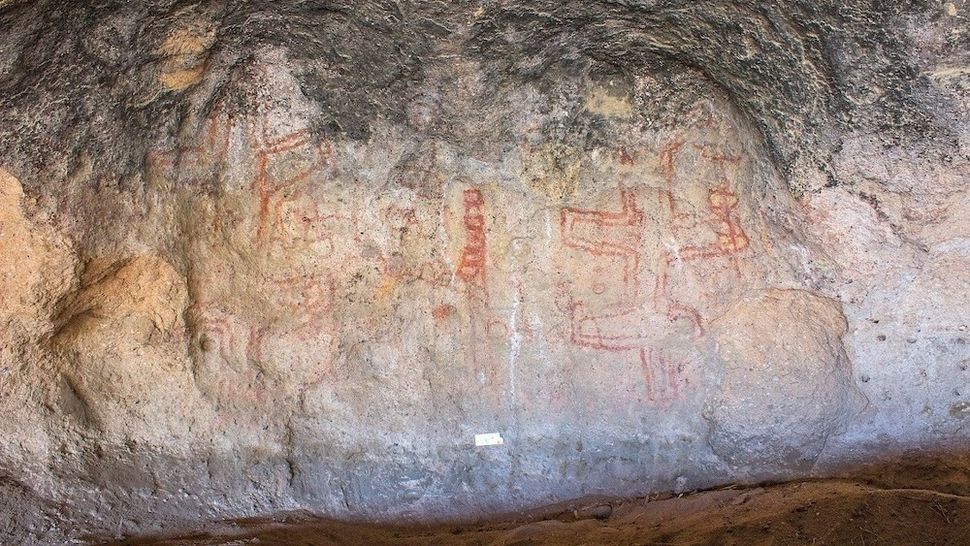Latin America
Related: About this forumAncient rock art in Argentinian cave may have transmitted information across 100 generations
By Jennifer Nalewicki
published 1 day ago
A cave in Patagonia houses the oldest known pigment-based rock art in South America.

A cave wall with rock art
Examples of some of the rock art found inside a cave in Patagonia. (Image credit: GRV)
A gallery's worth of rock art decorating the inside of a cave in Argentina is several millennia older than once thought and contains hundreds of drawings that span 100 generations.
At one time, archaeologists dated the art — located in Patagonia, a region in South America's southern tip — as being only several thousand years old. But a new analysis has revealed that some of the works actually date to as early as 8,200 years ago and were created during the late Holocene epoch (11,700 years ago to present), according to a study published Wednesday (Feb. 14) in the journal Science Advances.
"It turned out to be several millennia older than we expected," study lead author Guadalupe Romero Villanueva, an archaeologist with the Argentine National Research Council (CONICET) and the National Institute of Anthropology and Latin American Thought (INAPL), told Live Science. "We got surprised."
To determine the date of the massive artwork, which depicts humans, animals and other designs, archaeologists chipped away several small pieces of black pigment from the drawings. Since the pigment was made from plant material, researchers used radiocarbon dating to determine the age of the cave art.
More:
https://www.livescience.com/archaeology/ancient-rock-art-in-argentinian-cave-may-have-transmitted-information-across-100-generations


(Interesting how ancient people painted the same hand prints on rock walls all over the world, isn't it?

The canyon walk at Cueva de Las Manos.
(Cave of the hands)


Easterncedar
(3,587 posts)I can’t imagine it.
Judi Lynn
(162,441 posts)It will be amazing once they discover how to understand what has been here all this time!
8,700 years is even longer than the 6,000 years fundamentalists say it took gawd to make the earth!
Easterncedar
(3,587 posts)But that span of time confounds me, too.
And I got my degrees in history.
Bernardo de La Paz
(51,030 posts)2naSalit
(92,955 posts)I have been to several sites in the western US and the animal shapes are represent almost exactly the same, they have numerous common symbols.
If you listen to traditional indigenous music on the different continents you'll find many similar sounds and songs as well as instruments including bird bones as whistles. The commonalities in what remains of ancient cultures are numerous.
Bernardo de La Paz
(51,030 posts)Judi Lynn
(162,441 posts)Dating to as early as 8,200 years ago, the paintings may have maintained collective memories during an extremely dry period in history
Will Sullivan
Daily Correspondent
February 15, 2024 3:32 p.m
Ancient art in a Patagonian cave is several thousand years older than archaeologists previously thought, researchers reported Wednesday in the journal Science Advances. The depictions date to 8,200 years ago at the earliest and span around 3,000 years—suggesting 130 human generations painted on the cave’s walls and ceiling. The new findings make this the earliest known pigment-based cave art on the continent.
“It turned out to be several millennia older than we expected,” lead author Guadalupe Romero Villanueva, an archaeologist with the Argentine National Scientific and Technical Research Council (CONICET), tells Live Science’s Jennifer Nalewicki. “We got surprised.”
The cave, called Cueva Huenul 1, is located in the desert of northwest Patagonia in Argentina, about 1,000 meters above sea level. Its walls hold 895 different paintings grouped in 446 motifs. People repeatedly drew one of the motifs, a mysterious comb-like pattern, for thousands of years.
“As interesting as the ages are, for us it’s more significant that they span, more or less, 3,000 years of painting basically the same motif during all this time,” co-author Ramiro Barberena, also an archaeologist with CONICET, tells the New York Times’ Becky Ferreira.
More:
https://www.smithsonianmag.com/smart-news/this-ancient-cave-art-passed-survival-information-across-130-human-generations-in-patagonia-study-suggests-180983802/